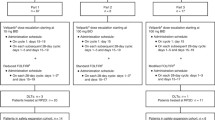Summary
Background Accumulating evidence shows evidence of efficacy with the combination of vorinostat and bortezomib in solid tumors. We previously examined a once-daily continuous dosing schedule of vorinostat in combination with bortezomib which was well tolerated in cycles 1 and 2; however, there was concern regarding the tolerability through multiple cycles. This study was conducted to evaluate an intermittent dosing schedule of vorinostat with bortezomib. Methods Vorinostat was initially administered orally twice daily on days 1–14 with bortezomib IV on days 1, 4, 8, and 11 of a 21 day cycle. Two DLTs (elevated ALT and fatigue) were observed at dose level 1, thus the protocol was amended to administer vorinostat intermittently twice daily on days 1–4 and 8–11. Results 29 patients were enrolled; 13 men and 16 women. Common cancer types included sarcoma, pancreatic, colorectal, GIST, and breast. The most common Grade 3–4 toxicities at any dose level included thrombocytopenia, fatigue, increased ALT, elevated INR, and diarrhea. DLTs in the intermittent dosing scheduled included thrombocytopenia and fatigue. The Cmax and AUC for the intermittent dosing regimen were similar to those observed in the daily dosing. In this heavily pretreated population, stable disease was observed in patients with sarcoma, colorectal adenocarcinoma and GIST. Conclusions The MTD was established at vorinostat 300 mg BID on days 1–4 and 8–11 and bortezomib 1.3 mg/m2 IV on days 1, 4, 8, and 11 of a 21 day cycle. Tolerability was not improved with the intermittent dosing schedule of vorinostat when compared to continuous dosing.
Similar content being viewed by others
References
You JS, Jones PA (2012) Cancer genetics and epigenetics: two sides of the same coin? Cancer Cell 22(1):9–20
Toyota M, Suzuki H (2010) Epigenetics of genetic alterations. Adv Genet 70:309–323
Lambert MP, Herceg Z (2008) Epigenetics and cancer, 2nd IARC meeting, Lyon, France, 6 and 7 December 2007. Mon Oncol 2(1):33–40
Workman JL, Kingston RE (1998) Alteration of nucleosome structure as a mechanism of transcriptional regulation. Annu Rev Biochem 67:545–579
Arts J, de Schepper S, Van Emelen K (2003) Histone deacetylase inhibitors: from chromatin remodeling to experimental cancer therapeutics. Curr Med Chem 10:2343–2350
Jones PA, Baylin SB (2002) The fundamental role of epigenetic events in cancer. Nat Rev Genet 3:415–428
Amin HM, Saeed S, Alkan S (2001) histone deacetylases inhibitors induce caspase-dependent apoptosis and downregulation of daxx in acute promyelocytic leukaemia with t(15:17). Br J Haematol 115:287–297
Peart MJ, Tainton KM, Ruefli AA, Dear AE, Sedelies KA, O’Reilly LA et al (2003) Novel mechanisms of apoptosis induced by histone deacetylase inhibitors. Cancer Res 63:4460–4471
Marks PA, Xu WS (2009) Histone deacytlase inhibitors: potential in cancer therapy. J Cell Biochem 107:600–608
Yu C, Rahmani M, Conrad D, Subler M, Dent P, Grant S (2003) The proteosomes inhibitor bortezomib interacts synergistically with histone deacetylases inhibitors to induce apoptosis in Bcr/Abl+ cells sensitive and resistant to STI571. Blood 103:3765–3774
Sato A, Asano T, Ito K, Sumitomo M, Asano T (2011) Suberoylanilide hydroxamic acid (SAHA) combined with bortezomib inhibits renal cancer growth by enhancing histone acetylation and protein ubiquitination synergistically. BJUI 109:1258–1268
Denlinger CE, Rundall BK, Jones DR (2004) Proteosome inhibitionsensitizes non-small cell lung cancer to histone deacetylase inhibitor – induced apoptosis through generation of reactive oxygen species. J Thoracic Cardiovasc Surg 128(5):740–748
Schelman WR, Traynor AM, Holen KD, Kolesar JM, Attia S, Hoang T, et al. A Phase I study of vorinostat in combination with bortezomib in patients with advanced malignancies. (Submitted)
Parise RA, Holleran JL, Beumer JH, Ramalingam S, Egorin MJ (2006) A liquid chromatography-electrospray ionization tandem mass spectrospray inonization tandem mass spectrometric assay for quantitation of the histone deacetylases inhibitor, vorinostat (suberoylanilide hydroxamicacid, SAHA), and its metabolites in human serum. J Chromatogr B Analyt Technol Biomde Life Sci 840(2):108–115
Ramalingam SS, Parise RA, Ramanathan RK, Lagattuta TF, Musguire LA, Stoller RG et al (2007) Phase I and pharmacokinetic study of vorinostat, a histone deacetylases inhibitor, in combination with carboplatin and paclitaxel for advanced solid malignancies. Clin Cancer Res 13(12):3605–3610
Acknowledgments
The authors would like to thank the University of Wisconsin Carbone Cancer Center (UWCCC) Analytical Instrumentation Laboratory for Pharmacokinetics, Pharmacodynamics, & Pharmacogenetics (3P Lab) for support in the acquisition of pharmacokinetic data for this research.
The authors also would like to thank the patients who participated in this clinical trial, and the nurses and research specialist of the UWCCC Cancer Therapy Discovery and Development Program for their efforts in conducting and managing this trial.
Disclosures
No potential conflicts of interest were disclosed.
Financial support
NCI, UO1, CA062491, NCI P30, CA014520, SAIC 25XS097, and 1ULRR025011. U01 CA69912, Phase I Trials of Anticancer Agents (Mayo Clinic); 23XS026, CTEP Translational Research Initiative - Support Subcontracts, Correlative Studies Core Laboratory for SAHA Phase I and Phase II Clinical Protocols (Mayo Clinic), SAIC-FREDERICK, INC.; funding from Merck.
Author information
Authors and Affiliations
Corresponding author
Rights and permissions
About this article
Cite this article
Deming, D.A., Ninan, J., Bailey, H.H. et al. A Phase I study of intermittently dosed vorinostat in combination with bortezomib in patients with advanced solid tumors. Invest New Drugs 32, 323–329 (2014). https://doi.org/10.1007/s10637-013-0035-8
Received:
Accepted:
Published:
Issue Date:
DOI: https://doi.org/10.1007/s10637-013-0035-8




